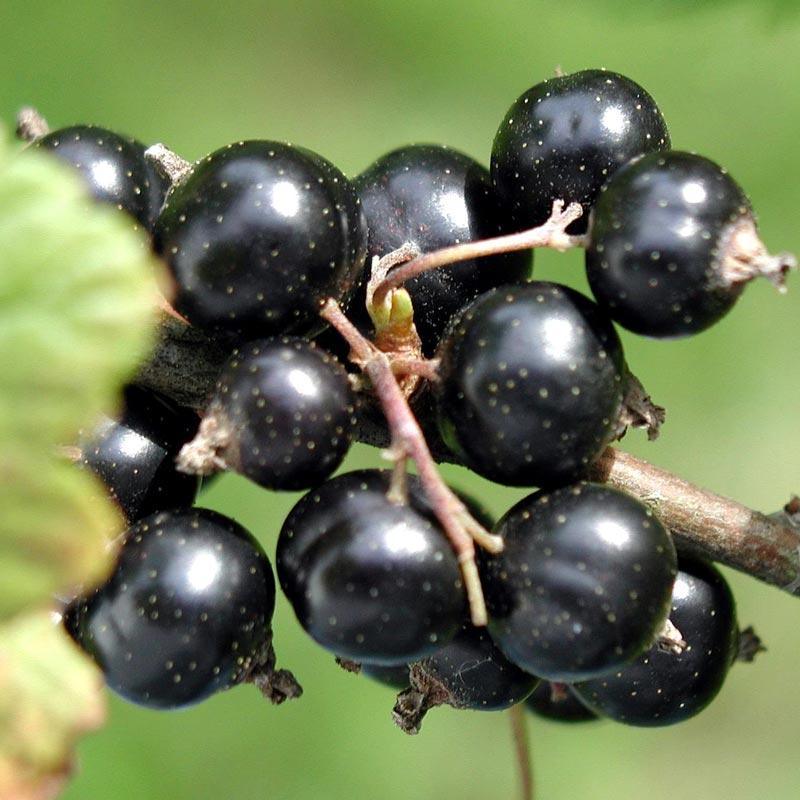Item Number: FV341
Black Consort Currant
Bold flavor, packed with potential.
Mix-and-match for free shipping when purchasing 6 or more perennial berries, vines, or crowns! Black Consort currants are a highly productive variety, offering small, dark berries with a bold, tart flavor. These versatile berries are ideal for making preserves, juices, or adding to baked goods. Thriving in full sun to partial shade and well-draining soil, Black Consort currants are cold-hardy and resistant to common diseases. The compact shrubs are easy to grow and produce abundant harvests in mid-summer. With their rich flavor and adaptability, Black Consort currants are a valuable addition to any berry garden.
Zones: 3-8
Harvest: June-July
Fruit: Very prominent, sweet and unique flavor.
Facts of note: Developed in Ottawa, Ontario and introduced in 1950. Medium clusters of somewhat soft black berries. Good for jams, juice and wine. Excellent when dried, very high source of Vitamin C. Excellent bird forage or windbreak plants.
Currants do not thrive in hot summers; you can plant them on the north side of a building if you have sustained summer heat over 90 °F. Self-fertile.
Susceptible to leaf spot and mildew. Resistant to white pine blister rust. Plant currants at least 3' apart.
Currants are a delightful addition to any garden, offering not only a burst of flavor but also a wealth of nutritional benefits. Among the various currant varieties available, Black Consort Currants stand out for their rich, dark color and deliciously sweet-tart taste.
The Allure of Black Consort Currants
Black Consort currants, scientifically known as Ribes nigrum, belong to the Ribes genus and are part of the currants and gooseberries family. These berries are distinct from Zante currants, often associated with dried Corinth grapes. Black Consort currants are characterized by their deep, translucent black color, making them easily distinguishable from other currant varieties. These berries are prized for their unique and intense flavor, a delightful blend of sweetness and tartness. If you’re intrigued by this bold currant, you may also want to explore the equally rewarding world of gooseberries — check out our Hinnomaki Red Gooseberry and browse our full gooseberry growing guide to learn how to cultivate them alongside your currants.
In addition to their rich flavor, Black Consort currants are versatile in their use. They can be enjoyed fresh, adding a burst of flavor to salads, desserts, or eaten on their own. Their unique color and taste make them a popular choice for various culinary creations, from jams and sauces to baked goods. Whether you're exploring the culinary world or simply enjoying them fresh, Black Consort currants stand out as a delicious and vibrant addition to the diverse family of currants and gooseberries.
Dark and Delectable: As the name suggests, Black Consort Currants boast a deep, almost black color when fully ripe. This rich hue is not only visually appealing but also an indicator of their sweet and slightly tart flavor profile.
Versatile Culinary Uses: These currants are prized in the culinary world for their versatility. They can be used in a wide range of recipes, from jams and jellies to pies, tarts, and even savory dishes. Their unique blend of sweetness and tartness adds depth to various culinary creations.
Nutritional Powerhouses: Black Consort Currants are not just delicious; they are also packed with nutrients. They are an excellent source of vitamin C, providing a significant portion of your daily recommended intake. Additionally, they contain essential minerals like potassium and dietary fiber, contributing to a well-rounded diet.
Cultivating Black Consort Currants
Growing Black Consort Currants can be a rewarding experience, whether you are a seasoned gardener or a novice. Here are some key considerations for successfully cultivating these currants:
Climate and Location: Black Consort Currants thrive in temperate climates. They are generally hardy and can withstand cold winters. Choose a sunny location in your garden with well-draining soil to ensure optimal growth.
Planting: Plant Black Consort Currants in early spring or late autumn when they are dormant. Space the plants approximately 4-6 feet apart to allow for proper air circulation and growth. Ensure that the soil is rich in organic matter and has a slightly acidic to neutral pH level.
Pruning: Pruning is essential to maintain the health and productivity of Black Consort Currants. Regularly remove dead or diseased branches, as well as any crowded growth in the center of the plant. Prune during the dormant season to encourage new growth.
Watering and Fertilizing: Keep the soil consistently moist but not waterlogged during the growing season. Applying a balanced fertilizer in early spring can support healthy plant development and fruit production.
Harvesting and Enjoying Black Consort Currants
The joy of growing Black Consort Currants culminates in the harvest and savoring of these delectable fruits. Here's how to make the most of your currant harvest:
Harvest Time: Black Consort Currants typically ripen in mid to late summer. When the berries turn dark and are easily plucked from the stem, they are ready to be harvested. Gently grasp the bunches and pull them from the bush.
Preserving: These currants are excellent candidates for preservation. You can make delightful jams, jellies, and preserves to enjoy their flavor throughout the year. Alternatively, freeze them for later use in smoothies, baked goods, or sauces.
Fresh Consumption: Of course, enjoying Black Consort Currants fresh is a treat in itself. Add them to your morning cereal, yogurt, or fruit salad for a burst of flavor. You can also use them in desserts or as a garnish for savory dishes.
Black Consort Currants are a delightful addition to any garden, offering not only their striking appearance but also their versatile culinary uses and nutritional benefits. Cultivating these currants is a rewarding endeavor, and their sweet-tart flavor can be enjoyed fresh or in various preserved forms throughout the year. Whether you are a seasoned gardener or a beginner, Black Consort Currants are a must-have for any fruit garden.
Preserving/Canning
Canning currants involves the process of preserving fresh fruits from fruit trees and fruiting plants to enjoy their flavors year-round. Start by selecting ripe fruits, ensuring they are in prime condition for canning. Wash and prepare the fruits, removing any pits or seeds as necessary. For added sweetness, consider adding sugar or syrup to enhance the flavor of the canned fruits. Some fruits may benefit from being frozen before canning, which can help maintain their texture and taste. The canning process typically involves sealing the prepared fruits in jars and using a water bath or pressure canner to ensure proper preservation. By following specific canning recipes and guidelines, you can create delicious fruit preserves that capture the essence of freshly grown fruits.
For more information, please enjoy our Growing Guide for planting and growing currants.
Visit our Berry, Vine & Crowns Characteristics Chart to compare growing characteristics for all our berries, vines, and crowns.


Check Your Zone Compatibility:
Compatible with your zone.
Growing Zone for

Our Guarantee To You
Since 1976, we've served our customers at every stage of growing. Please contact us at any time. We are happy to support and assist you.
Shipping Information
Shipping Information
Cannot ship to the following states: HI, MA, ME, MI, NC, NH, NJ, PR, RI, WV
Cannot ship via USPS.
Cannot ship via SmartPost.
Shipping Weight: 2.0 lb
Dimensions: 26.0"L x 2.5"W x 2.5"H
Features
Features
- Bare Root
- Long-Lived
- Self-fruitful
- Shade Tolerant
- Thornless
Characteristics
Characteristics
Planting & Care
Planting & Care
Useful Information
Useful Information
Guarantee
Guarantee
Limited Dormant Tree & Plant Guarantee
* Claim deadline is June 15th
We guarantee that your dormant tree or plant will arrive in good, viable condition. If your tree arrives in substandard condition, notify us within 3 days of delivery. Please email pictures of the box, inside packaging, the tree and its roots to helpdesk@groworganic.com. We will investigate your claim and process a request to exchange or refund the damaged product.
If your dormant tree or plant has not grown new leaves by June 15th, you may be eligible for our Limited Dormant Tree & Plant Guarantee. This guarantee provides for a store credit for the purchase price of the tree, excluding shipping. Please see the Instructions below.
Important Dates:
- April 1st Dormant trees/plants must be planted in the ground
- May 15th Perform scratch test, if no new leaves have grown
- June 15th Deadline to apply for a dormant tree/plant credit
All required documentation must be received by June 15th for your claim to be considered. Claims or documentation received after June 15th will be denied, without exception. Instructions listed below
Terms and Conditions
We cannot guarantee that your tree or plant will remain alive and healthy after it is received, or bear fruit as there are too many variables in your environment that are beyond our control (i.e. soil preparation, weed and pest control, proper irrigation, chill hours, compatible hardiness for your growing zone, proper choice of pollinator, extreme weather, rodent damage, disease, etc.).
We cannot guarantee that we will be able to provide a replacement tree/plant of the same species either that same growing season or in future years. Customers are responsible for all shipping fees associated with replacement trees and plants.
If we determine that the tree you purchased directly from us is not viable, we will issue you a store credit (not a refund) for the purchase price of the affected dormant tree or plant. Shipping is not included in the dormant tree/plant guarantee. Store credits can be used to purchase any product we sell and are valid for use only until July 1st of the following year.
Historically, 98% of our dormant trees and plants grow and thrive when they have been cared for and planted using our growing guides. Dormant trees and plants must be planted in the ground by April 1st in order to be eligible for credit. If the ground in your area is still frozen solid, you may temporarily plant your tree or plant in a pot.
Potted, non-dormant trees or plants are excluded from this guarantee as they are not dormant at the time of shipment. Evergreen trees such as citrus, avocado and olive trees are not available for credit under the Dormant Tree and Plant Guarantee.
Instructions
We guarantee that your dormant fruit tree or plant will leaf out, if you care for it according to our growing guides. In the unlikely event that your dormant tree or plant does not have leaves by May 15th, follow these simple steps to apply for a store credit:
Before you call or email, please perform a “scratch test” to determine if the tree or plant is still alive. This video shows how to check for live tissue under the bark. Scratch tests need to be done a few inches above and below the graft.
Green Cambium Layer / Living Trees
If the cambium layer under the bark is green, give your tree a little more time. It is still alive, but hasn’t come out of dormancy yet. Check to make sure that it is getting the right amount of deep root water, enough sunlight and that the weather is warm enough for that type of tree/plant to come out of dormancy. Every tree has its own personality and will come out of dormancy at different times. Be sure to submit the required documentation listed below by June 15th, if it doesn’t grow leaves.
Brown Cambium Layer / Dead Trees
If the scratch test shows a brown cambium layer or if your dormant tree/plant doesn’t have leaves by June 1st, please email us at helpdesk@groworganic.com. All required documentation listed below must be received by June 15th for your claim to be considered. To be considered for the guarantee claim, all required documentation must be received by June 15th. Incomplete submissions will be denied.
Required Documentation
- Order number
- Name of dormant tree/plant and the quantity affected
- Photos of each tree or plant showing:
- The roots (tree or plant must be pulled out of the ground)
- The scratch test areas
- The entire tree/plant
We reserve the right to not issue credit for items that have already been replaced. We also reserve the right to require photographic evidence that the tree/plant was not killed by root rot, rodent or mechanical damage.
Share

They arrived very heathy and have been doing great. I was surprised to see berry flowers starting already. I look forward to tasting the berries and hope I like them.
I love black currant since childhood. I ordered 2 bushes and they arrived in March in good condition. I planted them right away and now in May I see green berries coming out.
I love Red & White currants, have since I was lucky enough to visit to Italy as a child, and growing up around friends and family from Ireland, I knew of Black currants (from Ribena, Fruit Gums, etc.) and have loved Black Current jam & jelly since I first tried it as a kid! Black Currant jams and pies taste like black cherries cranked up to 11; just rich and delicious! When I first started trying to grow Currants in Sonoma, California (Zone 9a/8b) I wanted to try growing all three colors, and eventually got the hang of it (they generally prefer longer winters, cooler summers, and less aridness).
Once the plants started to really hit their stride while growing, I rapidly realized why I'd never seen Black Currants offered to be eaten raw... They often taste chemical-y, and the leaves when broken or crushed can give off an almost gasoline-like smell... That being said? They are still DELICIOUS when cooked!
The bare-root I got from PVFS was of a decent size, had healthy looking buds, and (when planted with attention and care) grew steadily and healthily. When first encountering the leaves' smell, I grew concerned -- DO NOT BE CONCERNED! When I first tried to eat the fruit raw, I became more concerned -- FEAR NOT!
I know a lot of the fun of growing berries is getting to eat them fresh off the plant as you wander by... these will not fit that bill. That being said? They *really* elevate a mixed-berry pie, or jam, add AMAZINGLY deep color, rich flavor, and should not be overlooked.
I planted my black currants as soon as weather permitted. Packaging was great, they arrived in good shape. They are growing well so far. Like others, cannot wait to see how they do in future. Working on ways to save the fruit for me & not the birds & squirrels!
I planted this in late winter/early spring ‘22 in a heavily shaded spot. Despite the shade and my heavy clay soil this plant is thriving. I can’t wait to see what it looks like in the coming months!




